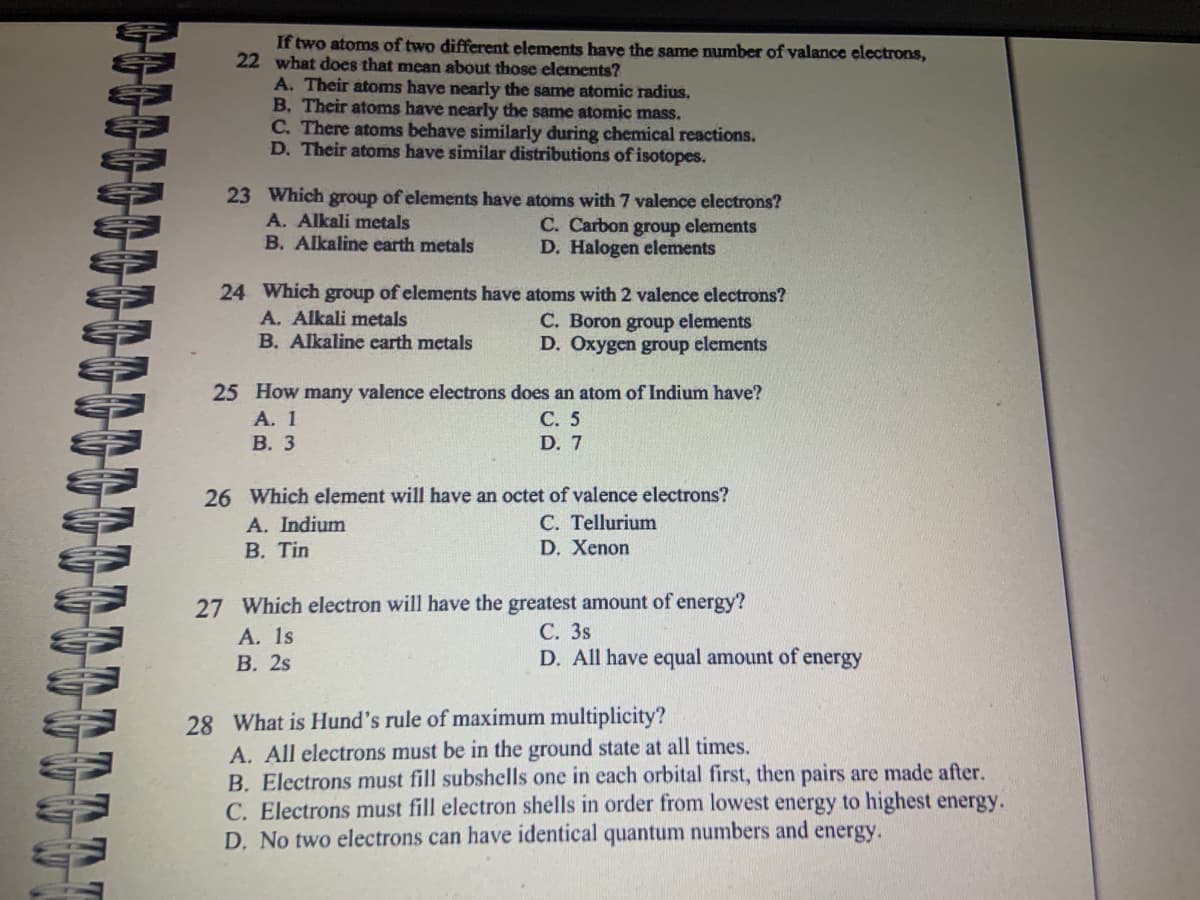ΙΠΠ If two atoms of two different elements have the same number of valance electrons, 22 what does that mean about those elements? A. Their atoms have nearly the same atomic radius. B. Their atoms have nearly the same atomic mass. C. There atoms behave similarly during chemical reactions. D. Their atoms have similar distributions of isotopes. 23 Which group of elements have atoms with 7 valence electrons? C. Carbon group elements D. Halogen elements A. Alkali metals B. Alkaline earth metals 24 Which group of elements have atoms with 2 valence electrons? C. Boron group elements D. Oxygen group elements A. Alkali metals B. Alkaline earth metals 25 How many valence electrons does an atom of Indium have? A. 1 C. 5 D. 7 B. 3 26 Which element will have an octet of valence electrons? C. Tellurium D. Xenon A. Indium B. Tin 27 Which electron will have the greatest amount of energy? C. 3s D. All have equal amount of energy A. 1s B. 2s 28 What is Hund's rule of maximum multiplicity? A. All electrons must be in the ground state at all times. B. Electrons must fill subshells one in each orbital first, then pairs are made after. C. Electrons must fill electron shells in order from lowest energy to highest energy. D. No two electrons can have identical quantum numbers and energy.
ΙΠΠ If two atoms of two different elements have the same number of valance electrons, 22 what does that mean about those elements? A. Their atoms have nearly the same atomic radius. B. Their atoms have nearly the same atomic mass. C. There atoms behave similarly during chemical reactions. D. Their atoms have similar distributions of isotopes. 23 Which group of elements have atoms with 7 valence electrons? C. Carbon group elements D. Halogen elements A. Alkali metals B. Alkaline earth metals 24 Which group of elements have atoms with 2 valence electrons? C. Boron group elements D. Oxygen group elements A. Alkali metals B. Alkaline earth metals 25 How many valence electrons does an atom of Indium have? A. 1 C. 5 D. 7 B. 3 26 Which element will have an octet of valence electrons? C. Tellurium D. Xenon A. Indium B. Tin 27 Which electron will have the greatest amount of energy? C. 3s D. All have equal amount of energy A. 1s B. 2s 28 What is Hund's rule of maximum multiplicity? A. All electrons must be in the ground state at all times. B. Electrons must fill subshells one in each orbital first, then pairs are made after. C. Electrons must fill electron shells in order from lowest energy to highest energy. D. No two electrons can have identical quantum numbers and energy.
Introductory Chemistry: An Active Learning Approach
6th Edition
ISBN:9781305079250
Author:Mark S. Cracolice, Ed Peters
Publisher:Mark S. Cracolice, Ed Peters
Chapter11: Atomic Theory :the Quantum Model Of The Atom
Section: Chapter Questions
Problem 92E: Determine whether each statement that follows is true or false: a Electron energies are quantized in...
Related questions
Question

Transcribed Image Text:If two atoms of two different elements have the same number of valance electrons,
22 what does that mean about those elements?
A. Their atoms have nearly the same atomic radius.
B. Their atoms have nearly the same atomic mass.
C. There atoms behave similarly during chemical reactions.
D. Their atoms have similar distributions of isotopes.
23 Which group of elements have atoms with 7 valence electrons?
C. Carbon group elements
D. Halogen elements
A. Alkali metals
B. Alkaline earth metals
24 Which group of elements have atoms with 2 valence electrons?
A. Alkali metals
C. Boron group elements
B. Alkaline earth metals
D. Oxygen group elements
25 How many valence electrons does an atom of Indium have?
C. 5
D. 7
A. 1
B. 3
26 Which element will have an octet of valence electrons?
C. Tellurium
D. Xenon
A. Indium
B. Tin
27 Which electron will have the greatest amount of energy?
C. 3s
D. All have equal amount of energy
A. 1s
B. 2s
28 What is Hund's rule of maximum multiplicity?
A. All electrons must be in the ground state at all times.
B. Electrons must fill subshells one in each orbital first, then pairs are made after.
C. Electrons must fill electron shells in order from lowest energy to highest energy.
D. No two electrons can have identical quantum numbers and energy.
Expert Solution
This question has been solved!
Explore an expertly crafted, step-by-step solution for a thorough understanding of key concepts.
Step by step
Solved in 4 steps

Knowledge Booster
Learn more about
Need a deep-dive on the concept behind this application? Look no further. Learn more about this topic, chemistry and related others by exploring similar questions and additional content below.Recommended textbooks for you

Introductory Chemistry: An Active Learning Approa…
Chemistry
ISBN:
9781305079250
Author:
Mark S. Cracolice, Ed Peters
Publisher:
Cengage Learning

Introductory Chemistry: A Foundation
Chemistry
ISBN:
9781337399425
Author:
Steven S. Zumdahl, Donald J. DeCoste
Publisher:
Cengage Learning


Introductory Chemistry: An Active Learning Approa…
Chemistry
ISBN:
9781305079250
Author:
Mark S. Cracolice, Ed Peters
Publisher:
Cengage Learning

Introductory Chemistry: A Foundation
Chemistry
ISBN:
9781337399425
Author:
Steven S. Zumdahl, Donald J. DeCoste
Publisher:
Cengage Learning



Chemistry
Chemistry
ISBN:
9781305957404
Author:
Steven S. Zumdahl, Susan A. Zumdahl, Donald J. DeCoste
Publisher:
Cengage Learning

Chemistry: An Atoms First Approach
Chemistry
ISBN:
9781305079243
Author:
Steven S. Zumdahl, Susan A. Zumdahl
Publisher:
Cengage Learning